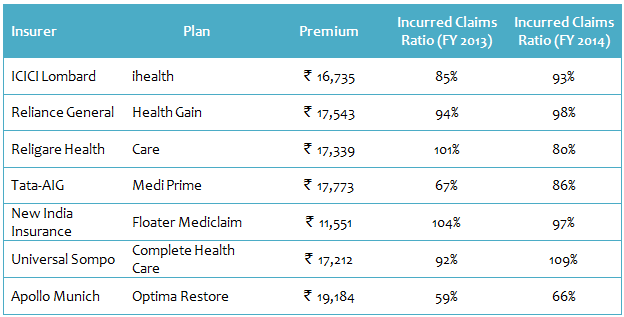
In the first part of our series, Best Health Insurance Plans in 2015: Individual Mediclaim, we had looked at the best individual Mediclaim plans, based on the most recent Mint Mediclaim ratings. Mint the leading financial daily rates Health insurance plans based on a variety of parameters like premiums, benefits and claims settlement track record of the insurer. In this part we will look at the best family floater plans, as per Mint's most recent Mediclaim ratings. While an individual Mediclaim policy covers only the insured, a family floater plan covers the entire family. The cover for the entire family is limited to the sum insured in a family floater plan. A family floater plan provides health insurance to the whole family at a lower cost compared to individual Mediclaims (please refer to our article, Which health insurance plan makes more sense: Individual Mediclaim or Family Floater). One disadvantage of a family floater plan is that the plan cannot be renewed, once the senior most member of the family reaches the maximum renewability age.
For our selection of the best family floater plans, we have looked at the overall score assigned to each family floater plan by Mint based on the following factors.
- Pricing or premiums
- Co-pay requirements
- No claim bonus
- Waiting period for pre-existing medical conditions
- Waiting period for specific diseases
- Disease wise capping
- Percentage of claims pending for over 6 months
- Percentage of claims not settled
We have selected the plans in the top quartile in terms of overall score assigned to the family floater plans by Mint. The table below shows the family floater plans in the top quartile of Mint's ratings, along with the premiums and the incurred claims ratio. Please note that the premiums are applicable to a family where the most senior member is 35 years old for a total sum insured of र 10 lacs. Further, please note that the incurred claims ratio is the ratio of the claims incurred by the insurer to the premiums earned by the insurer.

Conclusion
In this two part series, we have discussed the best Mediclaim plans based on the most recent Mint ratings. Health Insurance is a critical aspect of financial planning and should never be ignored. With a plethora of Mediclaim products available in the market, selecting the best Mediclaim plan is often confusing for health insurance buyers. If you are not sure, which product to buy, you should discuss with your financial advisor to help you select the right product. However, you should also educate yourself about Health Insurance, so that you can ensure that you are making the correct choice.
(Insurance is the subject matter of the solicitation. For more details on the risk factors, term and conditions please read sales brochure of the respective companies carefully before concluding the sale and/or contact an IRDA Licensed Insurance Advisor/ Insurance Broker)
Top 10 Tax Saving Mutual Funds to invest in India for 2016
Best 10 ELSS Mutual Funds in india for 2016
1. BNP Paribas Long Term Equity Fund
2. Axis Tax Saver Fund
3. Franklin India TaxShield
4. ICICI Prudential Long Term Equity Fund
5. IDFC Tax Advantage (ELSS) Fund
6. Birla Sun Life Tax Relief 96
7. DSP BlackRock Tax Saver Fund
8. Reliance Tax Saver (ELSS) Fund
9. Religare Tax Plan
10. Birla Sun Life Tax Plan
Invest in Best Performing 2016 Tax Saver Mutual Funds Online
For further information contact Prajna Capital on 94 8300 8300 by leaving a missed call
---------------------------------------------
Leave your comment with mail ID and we will answer them
OR
You can write to us at
PrajnaCapital [at] Gmail [dot] Com
OR
Leave a missed Call on 94 8300 8300
-----------------------------------------------